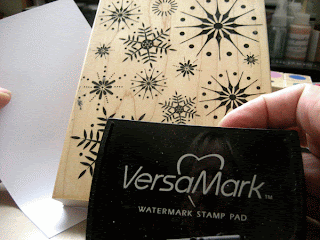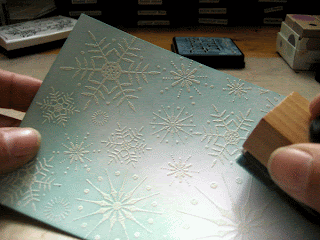
dinsdag 4 december 2012
Tim Holtz Comic - Magical Mystery Color
Here are all the panels of the 2012 Tim Holtz comic - Magical Mystery Color. I thought this would be an easy way to read them all at once. Just click on the first panel and enjoy the comic!


zondag 7 oktober 2012
Acrylic block and Bleaching
I got a lot of reactions like "how did you do that" on this card and the first card in this post. So I decided to do a photo tutorial. And to give credit where credit is due! This is NOT a technique I came up with. I saw it described in an article by Hermine Koster and I loved it! I don't know if she thought of it but she is the one who taught me this. So let's get started, shall we?
1. pick the distress colors you want with the stamp. Find an acrylic block slightly smaller than the stamp.
2. start coloring the acrylic block with the lightest color. I did it with distress markers but you can use any water based ink you want.
3. add touches of darker colors randomly on the block.
4. mist water over it to make the ink blend.
5. press where you want it on your paper. Give the ink time to seep into the paper.
6. you end up with something like this.
7. mask edges and blend in one of the lighter colors on the white spots.
8. this is the result I got after blending.
9. and now the magic trick: apply versamark ink to the edges of the acrilyc block only. It doesn't have to be neat. Little smears and spots only make it more interesting.
10. press block on your colored rectangle.
11. and there you have it. A lovely rectangle with blended distress colors.
12. stamp your image onto the colored block. make sure some part of the image is outside the rectangle. in this example it's just a tiny part of the tree and the snow outside the box. if you have a flower it is probably lovely to stamp it half in, half out of the rectangle.
13. take a bit of ink on your pencil and color in the appropriate "outside the rectangle" parts.
14. I just had to color the tree tops and a little bit below the rectangle.
15. another fun part! get some chlorine and start applying it where you want on your image. sometimes you just have to wait for the bleaching to start. so don't apply loads of it! do some little stripes first until you see how your color is going to react.
16. this is what you should end up with.
17. trim image to fit the card. cut another card slightly bigger than your image. I made it 1/4 inch larger. 1/4 inch gives a nice border, not too big, not too small.
Do you see my Tonic Guillotine in action? I love that trimmer!
18. color edges of the bordercard with appropriate color distress stains
19. glue your image on the bordercard. to avoid smudging the image I usually take a piece of scrap paper to cover it. experience taught me my fingers are not clean after this technique!
20. stamp sentiment where you want it. Slightly over the colored rectangle is usually a nice idea. Embellish as you want.
21. And here is finished card. this is a fantastic technique and I am glad to finally have made this tutorial. I hope you will give it a try too!

donderdag 6 september 2012
dubbel embossing - double embossing
Verzamel wat je nodig hebt voor het embossen voordat je begint. Embossing poeder, versamark (of een andere embossing inkt) papier. Dit voorkomt dat je na het afdrukken met de embossing inkt nog moet zoeken naar het juiste poeder! (ja, ik spreek uit ervaring!)
Collect what you need for embossing beforehand. Embossing powder, versamark (or another brand embossing ink), paper. This will prevent madly scrambling for supplies after stamping with versamark! (yes, been there, done that!)
Wat ik het mooiste vind van deze kaart is de tegenstelling tussen het drukke stempelen en de eenvoudige, strakke layout.
Final step: add embellishments. I used ice-blue gems and a sentiment.
What I like most about this card is the contrast. The stamping is wild and eratic (like snowflake often are!) but the card layout is straight and simple.

Collect what you need for embossing beforehand. Embossing powder, versamark (or another brand embossing ink), paper. This will prevent madly scrambling for supplies after stamping with versamark! (yes, been there, done that!)
Emboss the eerste stempel met witte embossing poeder.
Emboss the first stamp with white embossing powder.
Breng de eerste laag inkt aan. Begin met de lichtste kleur die je voor je kaart wilt gebruiken.
Apply first layer of ink. start with the lightest color you want to use on your card.
Droog de inkt en stempel de tweede stempel met versamark.
Dry the ink and stamp second stamp with versamark.
Gebruik transparante embossing poeder deze keer.
This time use transparant embossing powder and use heattool to set it.
Breng de tweede laag inkt aan.
Apply second layer of ink.
Het resultaat zou er zo uit moeten zien. Witte sneeuwvlokken en lichte punten waar de eerste laag inkt door de transparante embossing heen zichtbaar is.
The end result should look like this. White snowflakes and the spots show the first lighter layer of ink through the transparant embossing.
Omdat het vrij druk is geworden heb ik het in vierkantjes gesneden en de reststukjes bewaard.
Because it is quite a busy result I cut it into squares and a few rest pieces.
Vergeet niet om de randjes te inkten! Dit geeft een mooier afgewerkte indruk.
Do not forget to ink the edges! These little details make a good card look better.
Arrangeer de stukjes and plak 3D-blokjes onder éém ervan.
Assemble your pattern and raise one of the pieces with foam blocks.
Plak de onderdelen op de kaart.
Adhere to card and trim edges
Laatste stap: voeg extraatjes toe. Ik heb een paar ijs-blauwe blingsteentjes op de sneeuwvlokken geplakt en een tekst eronder gestempeld.Wat ik het mooiste vind van deze kaart is de tegenstelling tussen het drukke stempelen en de eenvoudige, strakke layout.
Final step: add embellishments. I used ice-blue gems and a sentiment.
What I like most about this card is the contrast. The stamping is wild and eratic (like snowflake often are!) but the card layout is straight and simple.

Abonneren op:
Reacties (Atom)













































